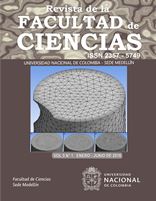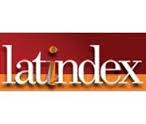Fundamentos conceptuales de una teoría de interferencia unificada para ondas y partículas
Fundamentals for a unified theory of wave and particle interference
DOI:
https://doi.org/10.15446/rev.fac.cienc.v5n1.55861Palabras clave:
Interferencia, ondas, partículas, coherencia (es)Interference, waves, particles, coherence (en)
Descargas
Referencias
Bach, R., Pope, D., Liou S. H. & Batelaan, H. (2013). Controlled double-slit electron diffraction. New Journal of Physics, 15.
Born, M., Wolf, E. (1993). Principles of Optics. Oxford.
Capelli, R., Toffanin, S., Generali, G., Usta, H., Facchetti, A. & Muccini, M. (2010). Organic light−emitting transistors with an effciency that outperforms the equivalent light−emitting diodes. Nature Mater, 9, 496-503.
Capozzi, B., Xia, J., Adak, O., Dell, E. J., Liu, Z. F., Taylor, J. C., Neaton, J. B., Campos L. M. & Venkataraman, L. (2015). Single-molecule diode with high rectication ratios through environmental control. Nature NanoTech, 10, 522-527.
Case, W. B., Tomandl, M., Deachapunya, S. & Arndt, M. (2009). Realization of optical carpets in the Talbot and Talbot−Lau congurations. Optics Express, 17, 20966-20974.
Castañeda, R., Muñoz−Ossa, H. & Cañas−Cardona, G. (2011). The structured spatial coherence support. J. Mod. Opt., 58, 962-972.
Castañeda, R. & Muñoz, H. (2013). Phase−space non−paraxial propagation modes of optical fields in any state of spatial coherence. Opt. Express, 21, 11276-11293.
Castañeda, R., Franco, E. & Vargas, D. (2013). Spatial coherence of light and a fundamental discontinuity of classical second−order wave-fronts. Phys. Scripta, 88.
Castañeda, R. (2014), Electromagnetic wave elds in the microdiffraction domain. Physical Review A, 89.
Castañeda, R. (2014). Three-dimensional micro-diffraction modelling. Appl. Opt., 53, 1782-1793.
Castañeda, R., Matteucci, G. & Capelli, R. (2016). Quantum interference without wave−particle duality. J. Mod. Phys., 7, 375-389.
Chapman, M. S., Ekstrom, C. R., Hammond, T. D., Schmiedmayer, J., Tannian, B. E., Wehinger, S. & Pritchard, D. E. (1995). Near−eld imaging of atom diffraction gratings: The atomic Talbot effect. Physical Review A, 51, R14-R17.
Davisson, C. J. & Germer, L.H. (1927). The scattering of electrons by a single crystal of nickel. Nature, 119, 558-560.
De Broglie, L. (1930). An introduction to the study of wave mechanics. Methuen & Co.
Martini De, F., Denardo, G. & Zeilinger, A. (1994). Quantum Interferometry. World Scientic.
Feynman, R., Leighton, R. & Sands, M. (1965). The Feynman Lectures on Physics, Volumen 3. Addison−Wesley.
Forrest, S. R. (2004). The path to ubiquitous and low-cost organic electronic appliances on plastic. Nature, 428, 911-918.
Frabboni, S., Gabrielli, A., Gazzadi, G. C., Giorgi, F., Matteucci, G., Pozzi, G., Cesari, N. S., Villa, M. & Zoccoli, A. (2012). The Young-Feynman two-slit experiment with single electrons: build−up of the interference pattern and arrival−time distribution using a fast−readout pixel detector. Ultramicroscopy, 116, 73-76.
Gelinck, G., Heremans, P., Nomoto, K. & Anthopoulos, T.D. (2010). Organic transistors in optical displays and microelectronic applications. Adv. Mater., 22, 3778-3798.
Grimaldi, F.M. (1665). Physico−Mathesis de Lumine Coloribus et Iride. Bononiae: Ex Typographia Haeredi Victorij Benatij.
Juffmann, T., Milic, A., Muellneritsch, M., Asenbaum, P., Tsukernik, A., Tuexen, J., Mayor, M., Cheshnovsky O. & Arndt, M. (2012). Real−time single−molecule imaging of quantum interference. Nature Nanotechnology, 7, 297-300.
Iannotta, S.; Toccoli, T. (2003). Supersonic molecular beam growth of thin lms of organic materials: a novel approach to controlling the structure, morphology, and functional properties. J. Polym. Sci.: Part B: Polym. Phys., 41, 2501-2521.
Iizuka, K. (1985). Engineering optics. Springer Verlag.
Mandel, L. & Wolf, E. (1995). Optical Coherence and Quantum Optics. Cambridge University Press.
Matteucci, G., Pezzi, M., Pozzi, G., Alberghi, G., Giorgi, F., Gabrielli, A., Semprini, N., Villa, M., Zoccoli, A., Frabboni, S. & Gazzadi, G. (2013). Build−up of interference patterns with single electrons. European Journal of Physics, 34, 511-517.
Newton, I. (2011). Principios matematicos de losofía natural. Trad.: Eloy Rada García. Alianza Editorial.
Piazza, L., Lummen, T.T.A., Quiñonez, E., Murooka, Y., Reed, B.W., Barwick B., Carbone, F. (2015). Simultaneous observation of the quantization and the interference pattern of a plasmonic near−eld. Nature Comm, 6, doi: 10.1038/ncomms7407.
Sepúlveda, A. (2003). Los conceptos de la física. Evolución histórica. Editorial Universidad de Antioquia.
Sugimoto, A., Ochi, H., Fujimura, S., Yoshida, A., Miyadera, T., Tsuchida, M. (2004). Flexible OLED displays using plastic substrates. IEEE J. Sel. Top. Quantum Electron., 10, 107-114.
Thomson, G.P. (1928). Experiments on the diffraction of cathode rays. Proc. Roy. Soc., 117, 600-609.
Young, T. (1804). The Bakerian lectures. Experiments and calculations relative to physical optics. Phil. Trans. Royal Society of London, 94, 1-16.
Xu, B., Xiao, X., Yang, X., Zang, L., Tao, N. (2005). Large gate modulation in the current of a room temperature single molecule transistor. J. Am. Chem. Soc., 127, 2386-2387.
Cómo citar
APA
ACM
ACS
ABNT
Chicago
Harvard
IEEE
MLA
Turabian
Vancouver
Descargar cita
CrossRef Cited-by
1. Román Castañeda. (2023). ¿CONFINA EL ESPACIO LIBRE A LAS ONDAS Y LAS PARTÍCULAS?. Revista de la Facultad de Ciencias, 12(1), p.24. https://doi.org/10.15446/rev.fac.cienc.v12n1.102032.
Dimensions
PlumX
Visitas a la página del resumen del artículo
Descargas
Licencia
Los autores o titulares del derecho de autor de cada artículo confieren a la Revista de la Facultad de Ciencias de la Universidad Nacional de Colombia una autorización no exclusiva, limitada y gratuita sobre el artículo que una vez evaluado y aprobado se envía para su posterior publicación ajustándose a las siguientes características:
1. Se remite la versión corregida de acuerdo con las sugerencias de los evaluadores y se aclara que el artículo mencionado se trata de un documento inédito sobre el que se tienen los derechos que se autorizan y se asume total responsabilidad por el contenido de su obra ante la Revista de la Facultad de Ciencias, la Universidad Nacional de Colombia y ante terceros.
2. La autorización conferida a la revista estará vigente a partir de la fecha en que se incluye en el volumen y número respectivo de la Revista de la Facultad de Ciencias en el Sistema Open Journal Systems y en la página principal de la revista (https://revistas.unal.edu.co/index.php/rfc/index), así como en las diferentes bases e índices de datos en que se encuentra indexada la publicación.
3. Los autores autorizan a la Revista de la Facultad de Ciencias de la Universidad Nacional de Colombia para publicar el documento en el formato en que sea requerido (impreso, digital, electrónico o cualquier otro conocido o por conocer) y autorizan a la Revista de la Facultad de Ciencias para incluir la obra en los índices y buscadores que estimen necesarios para promover su difusión.
4. Los autores aceptan que la autorización se hace a título gratuito, por lo tanto renuncian a recibir emolumento alguno por la publicación, distribución, comunicación pública y cualquier otro uso que se haga en los términos de la presente autorización.
5. Todos los contenidos de la Revista de la Facultad de Ciencias, están publicados bajo la Licencia Creative Commons Atribución – No comercial – Sin Derivar 4.0.
MODELO DE CARTA DE PRESENTACIÓN y CESIÓN DE DERECHOS DE AUTOR





















